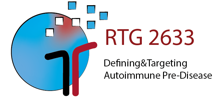Maj Jäpel
The role of AT1R antibodies and extracellular vesicles in mediating endothelial dysfunction in systemic sclerosis with pulmonary arterial hypertension
Systemic sclerosis (SSc) is a rare chronic disease characterized by the pathogenetic triad of fibrosis of the skin and internal organs, microvascular dysfunction, and dysregulation of autoimmunity. While skin fibrosis is the most typical factor present in patients with SSc, organ involvement determines the clinical outcome. Lung involvement primarily presents itself in the form of interstitial lung disease (ILD) and pulmonary arterial hypertension (PAH). At the molecular level, autoantibodies (abs) directed against G protein-coupled receptors (GPCRs) are thought to play an important role in modulating pathological mechanisms in SSc. In particular, abs targeting endothelin-1- (ETAR) and angiotensin II type 1 receptors (AT1R) have been identified to play a major role concerning the pathogenetic mechanisms of microvascular damage and are linked to an increased risk of suffering from vascular and fibrotic complications. In addition, the elevated amount of anti-GPCR abs is generally accompanied by an increased secretion of extracellular vesicles (EVs) in SSc. Taken together, the relevance of studying anti-GPCR abs together with GPCR-containing EVs in SSc pathogenesis becomes evident. Furthermore, monocytes are correlated with pulmonary artery pressure and mortality in SSc with PAH. This may indicate an important role of monocytes in the pathogenic processes in the lung, particularly in the cross-talk between monocytes and the endothelium. Regarding the latter, particular the endothelial glycocalyx (eGC) will be analyzed using atomic force microscopy (AFM). The state of the glycocalyx allows conclusions on the functions of endothelial cells. In the MD A4 project of Solveig Schmidt, pooled sera of SSc patients with interstitial lung disease (n=4) induced a shedding of the eGC of HUVEC in comparison to pooled sera of age- and sex-matched healthy controls (HC). This project aims to study structural and functional changes of the endothelial glycocalyx after stimulation with IgG containing AT1R or a recombinant monoclonal AT1R ab in conjunction with EVs, obtained from patients with SSc-PAH and HC, by AFM. Moreover, I would like to answer the question whether signs of endothelial dysfunction exist after stimulation with SSc-IgG containing AT1R abs and EVs. In addition, I will examine the cross-talk between endothelium and monocytes by analysing the eGC after stimulation with the supernatant of AT1R mab-primed human monocytes

- People
- Doctoral Candidates
- Merabell Adem
- Katja Adriany
- Farbod Bahreini
- Estelle Bergmann
- Swayanka Biswas
- Jana Buhre
- David De Luca Laredo
- Kaan Ersoy
- Ferdinand Gebauer
- Sen Guo
- Veronika Hartmann
- Michelle Hein
- Luise Janusch
- Maj Jäpel
- Anna Knauer
- Valentin Kneitz
- Maximilian Lahmer
- Wing Yu Lee
- Daniel Mehlberg
- Sahar Mehrabani
- Afsaneh Mehrpouyan
- Sadegh Mousavi
- Milica Novovic
- Justus Ohmes
- Bianca Opelka
- Colin Osterloh
- Cristian Papara
- Tina Rastegar Lari
- Rochi Saurabh
- Alessia Maria Sbaraglia
- Jovan Schanzenbacher
- Mareile Schlotfeldt
- Carolin Schmidt
- Solveig Lea Schmidt
- Leon Schmidt-Jiménez
- Nora Schoell
- Salomini Sinnathurai
- Sarah Stenger
- Chiara Walczyk
- Nele Wellbrock
- Julia Wimmer-Gross
- Natalia Zappe
- Jianrui Zheng
- Luca Zillikens
- Carla Zünkeler
- Principal Investigators
- Associated Scientists
- Administration
- Doctoral Candidates




